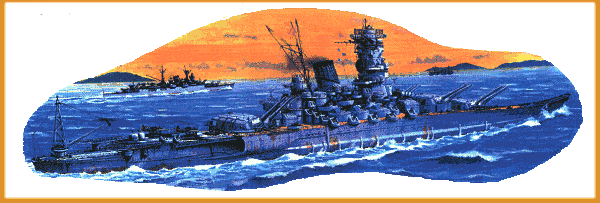



| Displacement | 70,000 tons |
| Armament | 3 x 2 20" Others same as Yamato |
| Aircraft | 6 floatplanes |
| Speed | 27.5 knots |
| VTS Rating | 7 10 5 |
While the Yamato class battleships were being built, their "successors", hull numbers 798 and 799, were being designed as slightly heavier versions having twin 20" guns in each of three turrets instead of triple 18". The Japanese didn't have enough shipbuilding capacity, stockpiled steel, or armor to make them, but if built they would have had the largest guns on the largest hull ever afloat in the world. One complication, first discovered in the Yamato class as well, was the unexpected intensity of the muzzle blast. Ship's personnel had to be behind heavy steel or armor not to be severely traumatized by the concussive effects, not to mention flash burns.
In "Grand Fleet" the first hull, her construction idled by the shortage of heavy armor production, is stretched and made into the super-carrier Yonaga. Satsuma is ready in 1942, and a sister is just beginning. Faced with a dearth of 20" guns and increasing pressure from the "aviator's club" to convert all "useless" battleships to aircraft carriers, the "gun club" makes a deal to build one last, great battleship with material from two others. The Settsu and Yamato become incorporated into the leviathan Yokozuna.
Satsuma became part of the "Hashirajima Fleet" in home waters, ostensibly waiting for the "Decisive Battle" to come along. She picked up the nickname "Sumo" in the press as a moniker for her size and strength, but was derided by the aviators as "like a Sumo wannabe--gaining weight by idleness and feasting on resources without ever going into the ring". When Allied forces invaded the Philippines at Leyte, though, the "Decisive Battle" was at hand and Satsuma and Yokozuna sailed together into the fray. Turned back by massive air attacks, they regrouped at night and circled back onto the invasion site. Incredulous Allied sailors watched in awe as the huge ships appeared over the horizon at dawn and began shelling the landing craft and escorts. The bulk of Allied seapower had been lured away to the decoy ships in the North by Adm. Ozawa's accurate reading of Adm. Halsey's inclinations, and was out of position to intervene. "Wormholes" almost two feet across started appearing in Allied ships as the long-fused Japanese armor-piercing shells bored right through the soft-skinned ships and exploded on the other side. The two battleships kept right on coming, ramming and slicing through the smaller landing craft and using their secondary guns to shell the LSD's and LST's circling offshore.
Their plan was to link up with the IJN Southern Force, but garbled communications seemed to indicate that the Southern Force was thoroughly defeated by a "wall" of battleships, torpedo boats and mines. Turning back and slicing through the landing ships again, the twosome headed North for the comparative safety of the Sibuyan Sea, if only they could make it through the San Bernadino Strait before Halsey's battleline could intercept. Just short of their goal, they came within range of Halsey's fast battleline as darkness fell. Though both Japanese ships had crude radar, the blast damage and small artillery fire from the landing escorts had caused "chatter" that obscured the oncoming Americans, and the American's superb fire-control radar began directing accurate fire from over the horizon. The Japanese duo withstood tremendous punishment and dished it out as well, but were gradually overcome by sheer weight of shell accurately delivered. Their burning hulks were extinguished as the sea closed over them within sight of the Strait. Satsuma had just fought in History's last "Line of Battle" ship duel.


